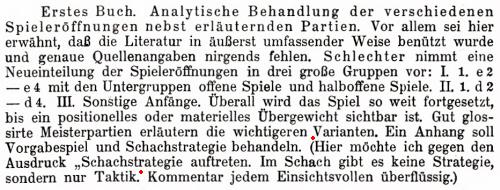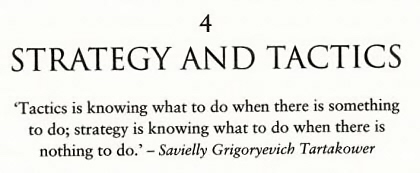
Edward Winter
Emanuel Lasker writing about Dawid Janowsky on page 60 of the February 1911 edition of the Berliner Zeitung:
‘This, in my judgement, is the Janowsky problem. His brain is stored with tactical ideas in myriad forms. He has them arranged and possesses the power to mobilize them and bring them to bear on any given position. If success is to be reached by any combination lying fathoms deep in the position, his tireless energy and creative fancy will find it and fashion it. But has he the presentiment necessary to detect the gradual grouping of the factors of such a position? Has he more than the energetic and teeming brain of the tactician; is he a strategist in addition? This last demands intellectual qualities rarely found in prodigal temperaments ... If the strategist preserve his intellectual energies, he invariably wins against the tactician.’
(1109)
‘Chess is 99% tactics’ is a famous quotation, usually ascribed to Richard Teichmann. The best corroboration we can offer comes from page 134 of volume 4 of Schachtaktik by E. Voellmy (Basle, 1930):
‘Zu meinem Trost hat der grosse Meister und Lehrer Teichmann mir vor Jahren in Zürich auseinandergesetzt (wobei er leicht übertrieb): “Das Schach besteht zu 99% aus Taktik”.’
(2307)
A quote from page 3 of The Middle Game in Chess by Reuben Fine (New York, 1952):
‘Among players of equal strength, it is always the last blunder, and the ability to see it, that determines who will win. At every level of chess skill, including the world championship class, it is still true that tactics is 99 per cent of the game.’
(2339)
A footnote on page 342 of A Chess Omnibus mentioned that many variations have been seen. For instance, on page 137 of the July 1955 Chess World C.J.S. Purdy wrote, ‘Kostić once said chess was 90% tactics, and he was right – not necessarily in the precise figure but in the general idea it conveys.’
From Better Chess by William Hartston (London, 1997 and 2003):
‘Think strategies when it’s your opponent’s turn to move; sort out the tactics while your own clock is running.’ (Page 50 of the latter edition.)
(5884)
See also C.N. 5889.
From page 103 of Chess Rules of Thumb by Lev Alburt and Al Lawrence (New York, 2003):

‘Rudolf’ Teichmann is unknown in the chess world.
The following was on page 97 of Chess Marches On! by Reuben Fine (New York, 1945):
‘Thirty years ago Teichmann said that chess is 99% tactics.’
(8738)
On page 98 Fine added:
‘Tactics is still more than 90% of chess.’
On page 181 of his book Wonderful world of chess (published by ‘Chess press, Munchen’, undated) Dimitrije Bjelica attributed to Teichmann (‘Teichman’): ‘Chess is 99 of tactisc.’
On page 195 of The Art of Positional Play (New York, 1976) Reshevsky agreed with the remark regularly ascribed to Teichmann, ‘Chess is 99% tactics’.
An addition on the same theme comes from an article entitled ‘Der neue Bilguer’ by Josef Krejcik on pages 230-232 of the August-September 1913 Wiener Schachzeitung:

The marked passage states:
‘Here I wish to speak out against the term “chess strategy”. In chess there is no strategy, but only tactics.’
From page 41 of the London, 2007 edition of Kasparov’s How Life Imitates Chess:

In the US edition (New York, 2007) this ‘Tartakower quote’ is in the heading to Chapter 3, on page 36. But did Tartakower make such a remark and, if so, where and when?
The earliest citation that we can currently offer is nothing better than a ‘once’ reference in an article about Fischer by Harold C. Schonberg on page SM63 of the New York Times, 23 February 1958:

The article was reproduced on pages 49-55 of The Joys of Chess by Fred Reinfeld (New York, 1961), still with the initial T. for Tartakower’s second forename. Schonberg also ascribed the quote to Tartakower on page 160 of Grandmasters of Chess (Philadelphia and New York, 1972), and it is regularly seen in chess books, without a source. For instance, Gary Lane used it to fill a corner on page 57 of Prepare to Attack (London, 2010).
In his entry on aphorisms on page 16 of The Encyclopedia of Chess by Harry Golombek (London, 1977) Wolfgang Heidenfeld included the following:
‘“Whereas the tactician knows what to do when there is something to do, it requires the strategist to know what to do when there is nothing to do” (Abrahams).’
Heidenfeld gave no source, but we have found the remark on page 150 of Abrahams’ book Teach Yourself Chess (London, 1948), although with ‘strategian’ instead of ‘strategist’.
Furthermore, the following can be quoted from page 152 of The Handbook of Chess by Gerald Abrahams (London, 1965):
‘At many stages of the game the general choice is available; what to do now that there is no coercion? Epigrammatically, it may be said: Tactics are what you do when there is something to do. Strategy is what you do when there is nothing to do. That isolation, however, is rare. Strategy is a feature, albeit unobserved, of most good tactical play. It is latent – not patent.’
(8833)
C.N. 10497 gave some extracts from Abrahams’ article ‘Reflections after Reykjavik’ on pages 84-90 of Encounter, March 1973. The observation below concerns the third game of the 1972 world title match:
‘In this game Fischer gave the friendly critic many reasons for admiration. First, he showed that chess strategy can be dynamic: not only knowing what to do when there is nothing to do; but a line of thought in which the tactics and the shaping of the game are integrated in purposeful play, involving a clear vision of long and subtle variations. This is great chess.’
From page 39 of The Secret of Tactical Chess by Fred Reinfeld (New York, 1958):
‘To the average player there is no, or little, distinction between strategy and tactics. Yet he will be a better player if he can perceive that distinction and turn it to account.
We might simplify considerably and say that strategy is the art of constructing advantageous situations, while tactics is the art of turning these advantageous situations into victory.
If the first explosion of the atomic bomb is considered as tactics, then all the planning, the calculations, the experiments, the interchange of knowledge, the organization of diverse skills, the stockpiling of needed materials – all these elements comprise strategy.’
C.J.S. Purdy wrote an article entitled ‘Strategy and Tactics’ on pages 123-124 of the August 1964 Chess World, concerning a game that he had won, as Black, against B. Berger in that year’s New South Wales championship. His remarks included:
From page 2 of Strategy & Tactics in Chess by M. Euwe (London, 1937):
‘Strategy is concerned with the setting of an aim and the forming of schemes. Tactics are concerned with the execution of the schemes. Strategy is abstract, tactics are concrete. Expressing it in a popular way: Strategy requires thought, tactics require observation.’
From page 50 of How To Win in the Middle Game of Chess by I.A. Horowitz (New York, 1955):
‘Tactics, the masters agree, are about 99% of the game; strategy only 1%. Yet, strangely enough, the highest degree of the art of chess is reached by the perfect blend of the two. There is no question, however, where the emphasis is placed.’
On page 4 of The Inner Game of Chess (New York, 1994) Andrew Soltis asserted:
‘He [a master] knows the old saying that “Chess is 99% tactics”, but he also knows it’s inaccurate. Chess is really 99% calculation – the inner game of chess.’
Some observations by C.J.S. Purdy on page 74 of the Australasian Chess Review, 30 March 1938:
‘What is it that really distinguishes strategy from tactics?
... When the player begins calculating on the basis of possible replies, he enters the realm of tactics.
In other words, we must arrive at definitions which indicate that tactics is the part of chess thinking based on calculation move by move, and that strategy is the part of chess thinking that is concerned with aims and plans (which are one side’s moves only). In actual play, the two are sometimes inextricably interwoven, but however much you tangle two different pieces of string, they remain two different pieces.’
To the Archives for other feature articles.
Copyright: Edward Winter. All rights reserved.